The history of twentieth-century translation of Sense and Sensibility in Spanish is strongly linked to the release of movie adaptations. Before 1940, only three of the six Jane Austen novels had been published in that language (Persuasión in 1919, La abadía de Northanger in 1921, and Orgullo y prejuicio in 1924). After the release of MGM’s Pride and Prejudice, the other three were finally translated, making Sense and Sensibility the fourth to appear in print, with a delay of more than 130 years. Afterwards, the novel would remain out of print for almost half a century, until the premier of the 1995 award-winning cinema adaptation, directed by Ang Lee, with a screenplay by Emma Thompson. Since then, it certainly has acquired long legs: as Aída Díaz Bild points out, around twenty-two editions had appeared by 2007 and perhaps a score more since, some of which might not be discussed or listed here.
As we will see, however, readers need to differentiate between editions and translations. Several editions can share the same translation while only the covers differ, either because one publishing house has printed and reprinted it with new covers or because a translation has been acquired by another company, and it appears in their different imprints. The matter is further complicated with digital editions and independent publishing, since almost anyone can take a public domain work, print it, and sell it as if it were his/her own translation. Keeping track of editions is nearly impossible, but at least in Spanish, readers should distrust the accuracy of the text if the edition is not published by a well-reputed publishing house, if its price seems too economical, or if the translator is not credited. Even meeting these basic requirements cannot be a guarantee.
Usually, the translator remains invisible to readers until they perceive a mistake. Only then will readers ask which translation is best, and suggestions often lead to a contentious discussion with no definitive answer. Inevitably, something is always lost in translation. The perfect translation is a chimera, an impossible dream. Determining the best translation, therefore, depends on the purpose of the translation and its target reader (i.e., a young reader, a college student, an average reader, a fan).
A challenging title
What makes a good Austen translation? We Janeites probably would say that the best translation remains as close as possible to what Jane Austen originally wrote. But not even a word-by-word translation would be intelligible since there is not a 100 percent equivalence between languages, and time and place should be considered. More than two hundred years separate Jane Austen’s English and twenty-first-century Spanish. The significant diversity from rendering the title in Spanish demonstrates how difficult it is to capture the essence of the words “sense” and “sensibility.” None of the other Austen’s novels presents such a difficulty1:
1942 Juicio y sentimiento (Judgment and Feeling/Sentiment)
1946 Cordura y sensibilidad (Sanity and Sensibility)
1965 Hacia la dicha por la senda del amor (Towards Blissfulness through the Path of Love)
1996 Sentido y sensibilidad (Sense/Meaning/Direction and Sensibility)
Sensatez y sentimientos (Good Sense and Feelings/Sentiments)
Sensatez y sensibilidad (Good Sense and Sensibility)
2010 Sensatez y sentimiento (Good Sense and Feeling/Sentiment)
Ellen Smith remembers another iteration from Argentina in the 1970s as Sentido común y sensibilidad (Common Sense and Sensibility) (21). I have not been able to trace any copy of such a book or even a record of it in that country or elsewhere.
One could argue that the most straightforward translation of the title would be Sentido y sensibilidad, but “sentido” is a polysemic word: in Spanish it can mean “sense” as well as “meaning” and “direction”; “juicio” has strong connotations with the legal context and, like “cordura,” with the healthy mental state. I would venture to say that “sensatez” is more suitable and accurate for the “sense” in the novel.
As for the second part of the title, the cult of sensibility did not develop as much in the Spanish-speaking world as in the English one, or perhaps what became more essential to Spanish translators was only its negative side, sentimentality, and thus “sentiments” or “feelings” have been preferred to “sensibility.” In addition, “sensibilidad” refers both to “sensibility” and “sensitivity.” Only once did a translator use the combination of “sensatez” and “sensibilidad,” and that was in a rare 1996 Chilean edition.
Furthermore, the variety of titles supports the mistaken notion that, as Jane Austen’s works in English are in the public domain, translations in other languages are also free from copyright—which is not exactly true. Depending on when the translation was published and if the translator did not pass away more than eighty years ago, the copyright remains, or at least it should. There are also editions credited to different people, but a side-by-side examination of these texts reveals that one copy is a rehash from a previous translation by another translator.
The array of titles also illustrates the Spain-centric status of book publishing in the Spanish language. Most Sense and Sensibility editions come from Spain and then are imported and distributed to the rest of the Spanish-speaking countries. That predominance has some logic, since statistics report that Spain ranks first among the Spanish-speaking countries in average books read annually, at almost ten books per year, while reading averages for larger Spanish-speaking countries (both in territory and population) are a little more than one book per year (Peña). But critics should consider economics too. Because income per capita in Latin America is lower than in Spain, people may not easily be able to afford a book or even find a particular book at a bookstore or a library. Furthermore, costs rise for books imported from Spain.
Since the mid-1990s boom, Austen’s works in translation have become easier to find. In Spain, finding books is quite simple because there is a wide range of editions; in Latin America, people still struggle to obtain copies, as not all the editions are available, and stocks are limited. Yes, buyers can order them online, but shipping costs may be exorbitant, or there may be other restrictions. Readers often have to content themselves with an e-book (if available). Just ask Argentinian Janeites about the challenges they face to obtaining copies. If we are fortunate, some editions can be found in Latin-American bookstores and libraries, but usually they are released first in Spain, and then months or years later they cross the Atlantic—but only if the publishing house has distribution on this side of the ocean.
Spain also has the advantage over the rest of the Spanish-speaking countries regarding recognition of translator’s rights. The results are mixed. Because translators are encouraged to have their work published, more translations are available. More translations, however, increase publishing costs; that increase then fuels the release of low-quality, though cheaper, editions and often results in stolen translations on both sides of the Atlantic.
Despite these disadvantages, and in part thanks to the popularity that the motion picture gave to the novel in the region, Sense and Sensibility is the Austen novel more Latin-American translators have tried to translate. It may be that translators are drawn to work on this novel because of its length: Sense and Sensibility has fewer words than Mansfield Park and Emma but is not as short as Persuasion or Northanger Abbey.
Editions, translators and adaptations
A. The first editions (1940s and 1960s)
Surprisingly enough, perhaps even the first translators of the novel were Latin American. Eighty years ago, Sense and Sensibility was first published in Spanish, in 1942, by Librería Nausica, a small and short-lived publishing house based in Barcelona. According to the catalogue of the Biblioteca Nacional de España (Spain’s National Library), between 1941 and 1946, Nausica published forty titles of American and European literature in pocket-size paperback editions, including Sense and Sensibility.
Nausica’s covers seem to have been simple and sober, in the same style that Calpe had issued its Colección Universal. The first editions in Spanish of Persuasion, Northanger Abbey, and Pride and Prejudice were part of that collection. All these editions have the same format: at the top, the author’s name; at the center, the title; and below, a medallion that represents Nausica. Also included is the publishing house name and address, with a frame in color—pale blue was the color chosen for Juicio y sentimiento.
That first edition includes an anonymous two-page biographical notice of Austen and no notes (in Spanish footnotes are preferred to endnotes). On the title page, María Teresa Moré is credited as translator, but no information about her is provided. Apparently, Juicio y sentimiento was the only book she ever translated, an assumption we can make because there are no other records about her as translator. Determining who she was is almost speculation: a Google search points towards a Cuban suffragette, founder and fine arts director of the Lyceum in Havana, Cuba (Eliot 54), and the first wife of Rafael Suárez Solís (1881–1968), a Spanish-Cuban writer and journalist, but nothing more can be found, not even her year of birth or death. Her translation of Sense and Sensibility includes one memorable anachronism (which will be discussed later). Copies of this edition are rare enough that Mari Carmen Romero omitted it in her account of the first Spanish translations. It is worth mentioning that in 2015 Biblok reissued Moré’s translation as Sentido y sensibilidad.
In 1946, four years after the first translation of Sense and Sensibility was released, Cordura y sensibilidad was issued by Ediciones Reguera, another Barcelonian publishing house, as number 46 of its Oasis collection. This collection featured the best novels from world literature, with illustrated covers by Roc Riera Rojas (Mengual Catalá), and it offered them at an economic price. The translation of Cordura y sensibilidad is credited to Fernando Durán, who ten years later would also translate Pride and Prejudice. Like many Spanish editions of Austen’s novels of those times, the characters on the cover do not wear Georgian or Regency attire but Victorian, replicating the image set by the 1940 film of Pride and Prejudice and showing how little was known about Austen’s historical context. Janine Barchas has placed these editions in what she calls the “pinking Austen” period of the publication of Austen novels, discussing Austen editions as examples of “la novela rosa” in the Spanish-speaking world (202–04, 220–23). The cover of Cordura and sensibilidad also evokes the idea of Little Women, featuring only the Dashwood sisters and no male characters.
The 1946 Cordura y sensibilidad was a paperback edition, printed in double columns on very cheap paper with no introduction, no notes, and merely a paragraph at the back of the title page to mention who Jane Austen was. As with Moré, it is difficult to determine who Fernando Durán was. Again, a Google search hints that he might have been Fernando Durán Villarreal2 (1908–1982), a Chilean author, journalist, and translator. If this identification is correct, the first and second editions of Sense and Sensibility in Spanish were published in Spain but translated by Latin Americans.
Durán hispanized the characters’ first names: thus, Elinor became Leonor; Marianne, Mariana; Margaret, Margarita; John, Juan; Edward, Eduardo; and, funniest of all, Fanny became Paquita (pet name for Francisca). Until the last decades of the twentieth century, such editorial decisions, which often disconcert and disgust twenty-first-century readers, were common. In 1942, however, Moré retained the English names.
As David Gilson records, in 1965 a condensed version of Sense and Sensibility was published in Spanish, as No. 1806 of the Revista literaria Novelas y cuentos, a weekly magazine that was published in Madrid between 1929 and 1966. With no more than seventy pages and printed on the very cheap paper usually used at the time for comics, it was the fourth Austen novel published by the magazine: Persuasion, Northanger Abbey, and Pride and Prejudice had been issued in the 1940s. Two peculiarities of this edition of Sense and Sensibility stand out: the title, Hacia la dicha por la senda del amor (Towards Blissfulness Through the Path of Love), is an inexplicable change, and the cover shows two wedding couples in Victorian dress. Neither the translator nor the person who oversaw the abridgement is credited, but the text seems to be entirely a third translation, since it is not a word-for-word reproduction of Moré’s or Durán’s. Neither does it seem to be an adaptation: it follows Austen’s wording, only omitting sentences within paragraphs, thus reducing descriptions and dialogues. Like Durán, the translator also Hispanized the names Leonor, Mariana, Margarita, etc., but Fanny became Francisca (Frances) not Paquita.
There is no evidence that these three editions were ever distributed or sold in Latin America; thus, apparently Sense and Sensibility remained confined to Spain during a great part of the twentieth century. These editions went out of print, and the novel was almost unknown for the rest of the Spanish-speaking readers until, as Díaz Bild notes, “after the release of Ang Lee’s cinematic adaptation of Sense and Sensibility” (189).
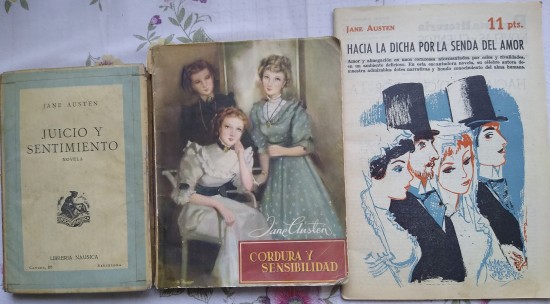
The first Spanish translations of Sense and Sensibility
(Click here to see a larger version.)
B. The 1995 boom
Two years before the release of the popular motion picture, in 1993, Juicio y sentimiento was translated again, this time by Luis Magrinyà, whose translation of the novel was published by Ediciones Rialp (Bermejo and Bernardo Gil 48). Magrinyà also wrote a prologue for the edition and included a few footnotes. Until then, covers for the editions had misrepresented the times of Austen, depicting the characters in Victorian attire, but for this edition one of Henry M. Brock’s 1898 illustrations was chosen, the first step toward placing Austen and her work in the Georgian era for Spanish-speaking readers.
Magrinyà’s translation of Sense and Sensibility has been considered among the best available in Spanish, and it has been reprinted several times, mainly by Alba Editorial as Juicio y sentimiento, but also by Ediciones B and Círculo de Lectores, and once as Sentido y sensibilidad by RBA, a translation of the title which Magrinyà considers nonsense or a misapplied calque (i.e., a word-for-word translation) (Bermejo and Bernardo Gil 50).

The 1993 Rialp edition, translated by Magrinyà
(Click here to see a larger version.)
Alba Editorial, founded in 1993, is a relatively young independent publishing house, and, since its very beginning, it has offered quality editions, with well-chosen covers and, usually, good translations. For its Austen editions, Alba offered sober and period-accurate covers with reproductions of Georgian paintings or illustrations. As editor for Alba, Magrinyà has been able to revise and reprint his translation, with minor corrections regarding carriages, incomes, and vocatives (or names) (Bermejo and Bernardo Gil 49). This edition could even be purchased as an e-book: Magrinyà’s 1993 prologue for the Rialp edition is no longer included, but at least his footnotes remain.
It should also be mentioned that since 2010 Grupo Editorial Tomo has been publishing Sensatez y sentimiento (notice the singular) in Mexico, a translation attributed to Roberto Mares. An examination of the text, however, coincides with Magrinyà’s translation.
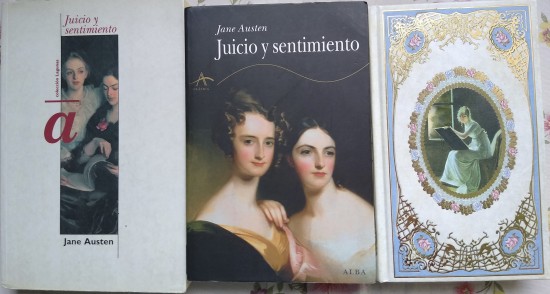
Other editions using Magrinyà’s translation
(Click here to see a larger version.)

Alba Editorial reprintings of Magrinyà’s translation
(Click here to see a larger version.)
The advent of the 1995 award-winning adaptation represented a worldwide commercialization of the novel. Publishing houses did not miss the opportunity to capitalize in the wake of the motion picture’s fame. The film was released in early 1996 in the Spanish-speaking countries under two different titles: Sentido y sensibilidad in Spain and Sensatez y sentimientos in Latin America. As Díaz Bild reported the reception only in Spain, it seems she was not aware of the alternate title on this side of the pond, because she mentioned that a translation from 2000 had “changed the original title to Sensatez y sentimientos” (189), when, in fact, four years earlier Latin American publishing houses had started using it.
In Spain, Orbis published Sentido y sensibilidad with the translation credited to Adelaida Montenegro. It was a hardback edition with no images on the cover. Since the publishing house disappeared at the end of the twentieth century, apparently this translation is no longer used, nor has it been recovered by other publishing houses. Unfortunately, it was completely overshadowed by another edition published at the same time.

Plaza y Janes movie tie-in edition with Rodríguez’s "translation"
(Click here to see a larger version.)
Plaza y Janés published Sentido y sensibilidad with the translation credited to Ana María Rodríguez. It was no. 292 of its Colección Jet. The cover showcases photos from the award-winning motion picture. In the coming years, Austen’s other five novels were added to the collection—the first time that the six main novels would be published in translation by the same publishing house. Plaza y Janés had distribution rights on both sides of the Atlantic; thus, the edition was also widely sold in Latin America, and, though the title could have confused some readers, the photos on the cover clearly revealed that it was the book on which the movie was based.
When in this century Plaza y Janés was acquired by Penguin Random House, Rodriguez’s translation became the one used for all this giant corporation’s imprints and reprintings, in particular, Debolsillo, Penguin Clásicos, and, more recently, Alfaguara. The reach of this translation is thus worldwide. Readers who search for the novel in well-known online bookstores will discover that editions using this translation are among the first to appear, both in print format and as e-book. In 2020 the Alfaguara edition included illustrations by the Spanish artist Maria Hesse, who has also illustrated Orgullo y prejuicio for that house. The Penguin Clásicos edition also includes a translation of Tony Tanner’s introduction for the novel, the introduction long used in their English edition.

Debolsillo reprintings of Rodríguez’s "translation"
(Click here to see a larger version.)

Other editions with Rodríguez’s "translation," including Penguin Clásicos
(Click here to see a larger version.)
Despite its wide availability, Rodríguez’s translation became infamous for having Colonel Brandon boarding a train (Fernández Sánchez). This flagrant mistake betrays something more: that Rodríguez’s version is not a bona fide translation but a rehash of the very first one, i.e., Moré’s translation from 1942. Since the latter had been out of print for more than half a century, few could have noticed that Rodríguez had not really translated but had instead only modernized the vocabulary and syntax of the old translation, without amending any semantic and cultural mistakes from 1942, and even adding some more. Rodríguez, for example, turned Mrs. Palmer into Lady Palmer. As a result of the mistakes, her supposed translation is among the worst available in the market. Iris Chryssofós noticed this “modernization” pattern in a Northanger Abbey edition (3–7), and it is true as well of the other five Austen novels published by Penguin Random House, including Sentido y sensibilidad. In other words, one of the world’s most powerful publishing conglomerates has settled for poor-quality mass production of Austen’s works in Spanish.

1996 Cuarto Propio edition in Chile
(Click here to see a larger version.)
Meanwhile, in South America, publishing houses were also printing their own editions of the novel in 1996. In Chile, for example, Cuarto Propio in collaboration with the Instituto Chileno-Británico de Cultura published Sensatez y sensibilidad, the only time the novel has been given that title in Spanish. It is a rare hardback edition with an elegant cover in beige, red, and sepia colors, simulating wallpaper and including the image of a woman in Regency dress, probably taken from one of the fashion magazines of the time, perhaps Ackermann’s Repository or the Lady’s Magazine. This edition also includes two-color images from the Regency era, making it the first illustrated edition of the novel in Spanish. In addition, most of Virginia Woolf’s essay on Jane Austen from The Common Reader is included as an introduction. The translator has not been credited, but the text follows Magrinyà’s translation with some modifications.
In Argentina, for its collection Serie del Rencuentro, A–Z Editora published in paperback Sensatez y sentimientos translated by the late Marcos Mayer (1952–2021), a famed Argentinian author and journalist, who also wrote a prologue for the novel. Very suitably, a painting of a picturesque English landscape was used for the cover. The edition is out of print, but the translation and the prologue were recovered in 2009 by Editorial Losada for its Grandes Clásicos collection. In this edition, the novel has the three-volume division. Unfortunately, post-Georgian portraits were used for the cover. Readers would have expected better from Losada since it is one of the oldest Argentinian publishing houses and has an excellent reputation.
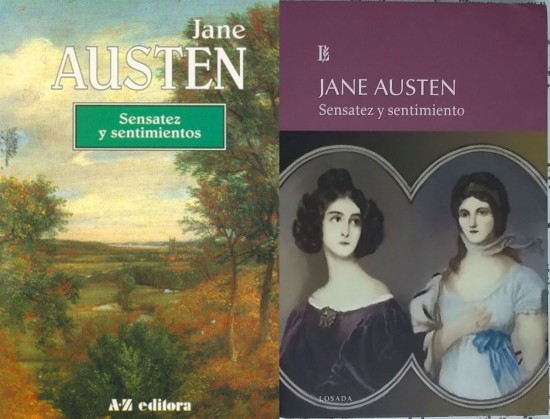
Two Argentinian editions using Mayer’s translation
(Click here to see a larger version.)
C. The early twenty-first century
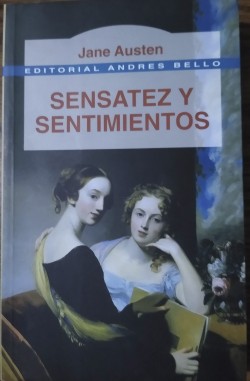
2000 Andrés Bello edition, translation by Paulina Matta
(Click here to see a larger version.)
The 2000 edition of Sensatez y sentimientos, which Díaz Bild has described, was published by Editorial Andrés Bello (after the famous Spanish-speaking linguist), a now defunct Chilean publishing house with branches in other Spanish-speaking countries, including Spain. This edition was published simultaneously in Chile and Spain and was distributed in other Latin American countries, such as Argentina and Mexico. A detail of Thomas Sully’s Portrait of the McEuen Sisters (1823) was used for the cover, though in later years it was unsuitably replaced with a detail from an Impressionist painting. The translation is attributed to Paulina Matta Vattier, an award-winning Chilean author and professor.
Unfortunately for Matta, her translation circulates freely on the Internet, and several publishing houses and digital editions plagiarize it in edition after edition. In 2013, for example, Plutón Ediciones in Spain published Sentido y sensibilidad, attributing the translation to Benjamin Briggent, but an examination reveals that the text is based on Matta’s translation, with small alterations to disguise the “loan,” and one can suspect Plutón used it again for its bilingual edition Sentido y sensiblidad/Sense and Sensibility in 2015. In Argentina in 2017 Ediciones Lea published Sensatez y sentimientos, edited and with a prologue by Rosa Gómez Aquino, and while no translator is officially credited, the text is based on Matta’s translation with slight modifications. In 2018 in Mexico Mirlo Ediciones issued Sensatez y sentimientos, crediting the translation to its own “translation team,” but the text is based on Matta’s translation. Two years later, in 2020, Editores Mexicanos Unidos (EMU) also published Sensatez y sentimientos. While Sergio Gaspar Mosqueda is credited as translator, this edition follows exactly the text published by Mirlo and therefore is based on Matta´s translation.

Editions in Spain and Argentina with "translations" based on Matta’s
(Click here to see a larger version.)
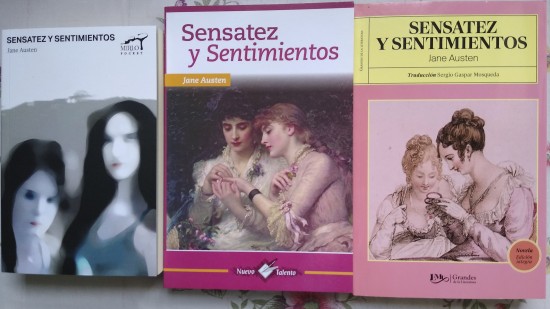
Mexican editions with "translations" based on Matta’s
(Click here to see a larger version.)
Other editions on both sides of the Atlantic credit different translators but do not bother to disguise Matta’s translation. Instead, they match it word for word. In Spain, the 2013 bilingual edition of Sentido y sensibilidad/Sense and Sensibility by Dualbooks, credits María Ciurana Cataluña as translator, but the text coincides with Matta’s. The same year, in Sentido y Sensibilidad by Olmak Trade, the translation is attributed to Francesc Luis Cardona, but the text also matches Matta’s. In Argentina, the 2013 Sentido y sensibilidad published by Terramar is a notable exception of a Latin American edition with the title preferred in Spain. Once again, no translator is credited, but the text coincides with Matta’s translation. Seven years later, also in Argentina, another Sentido y sensibilidad was published by Del Fondo Editorial, naming María Cecilia Lozano as translator, but the text, as Angélica Trejo has pointed out, follows Matta’s. In Sensatez y sentimientos, published in 2020 by Editorial Época (Mexico), no translator is credited, but again the text coincides with Matta’s translation.
In 2002 Edimat Libros issued in Spain its own hardback edition of Sentido y sensibilidad. The edition includes an introduction by Ivana Mollo on Austen's biography, context, and style. The translation is attributed to Clara Ituero Herrero. Overall, this edition is the most comprehensive presentation that has been published for the novel in Spanish for general readers, though the translation itself isn’t excellent. As Edimat has distributors in Latin America, its editions cross the Atlantic, and it has successfully reprinted the novel in hardback, paperback, double editions (with Orgullo y prejuicio), and most recently a revised edition in 2021 as the third volume (with a new translation of Persuasion) of its Jane Austen: Obra completa in four volumes, the first time that all of Austen’s fictional works, including all the juvenilia—not a selection—have been released by a single publishing house.

Edimat editions and reprintings, translation by Ituero
(Click here to see a larger version.)
Editions and translations continue to multiply. In 2013 Gradifco published Sensatez y sentimientos in Argentina, with a translation attributed to Juan Izquierdo. His translation, however, seems to be based on Ituero’s, with slight modifications to hide the resemblance. Two years earlier, in 2011, in Argentina, Grupo Planeta—another of the most important publishing conglomerates in Spanish—also released its own edition of Sensatez y sentimientos (also available as an e-book) with what seems a completely new translation, as it does not resemble the text of previous translations here registered. The translator is only identified as M. C.

Gradifco and Planeta editions in Argentina
(Click here to see a larger version.)

2013 Alianza edition, translation by López Muñoz
(Click here to see a larger version.)
Meanwhile, in Spain, Alianza Editorial published Sensatez y sentimiento (notice it is “sentimiento,” in singular, not plural) translated by José Luis López Muñoz. The change of title is remarkable, as Sentido y sensibilidad had become the standard in Spain. As Quico Rovira-Beleta, translator for the motion picture there—but who was not consulted about the title—pointed out, Sensatez y sentimiento is a more logical title (Bermejo and Bernardo Gil 50). Alianza, part of the Hachette group, is among the best reputed publishing houses in Spanish and generally offers good translations, particularly for its world’s literature catalogue. López Muñoz, an experienced and award-winning translator, whose career spans more than fifty years, has translated several great works in the English language. He is one of the few translators who has worked with more than one Austen novel. Sensatez y sentimiento represents his third collaboration with Alianza, the other publications being Emma (1972, revised in 1997) and Orgullo y prejuicio (1997).
In 2014 López Muñoz received the Esther Benitez award for the best translation published in Spain, awarded by ACE Traductores, the literary translators society of Spain, for his translation of Sensatez y sentimiento. No other translation of an Austen novel into Spanish has been similarly recognized, and this award is quite an achievement since it is granted by his peers. One could argue, however, against his decision to change the formality of the forms of address for the characters to given names (e.g., from “Miss Dashwood” to “Elinor”).

Alianza reprintings of López Muñoz’s translation
(Click here to see a larger version.)
López Muñoz’s edition belongs to Biblioteca de Traductores, a collection celebrating translators, a rarity in Spanish. It features a simple white cover and on the top left corner a small image, a detail of John Pettie’s painting Two Strings to Her Bow (1887). The edition does not offer an introduction, though it preserves the three-volume division and includes a few footnotes. Since then Alianza has reprinted the novel, changing the cover for each reprinting, a publication decision that matches the cover format for other Austen works published by Alianza: the main six novels plus Lady Susan y otras novelas (an edition that includes The Watsons, Sanditon, and “Love and Freindship”). In 2022 Alianza issued Sensatez y sentimiento as an e-book in Spain.

Alma Editorial illustrated edition
(Click here to see a larger version.)
More recently, in 2019, Alma Editorial published in hard-back Sentido y sensibilidad, its third illustrated Austen novel, and in 2022 Alma completed its illustrated set of the main six novels. Dàlia Adillon illustrated the novel, and Sara Alonso translated it, the most recent translation of the novel in Spanish. The three-color illustrations might be considered this edition’s main attraction, though they do not satisfy the taste of many Janeites, as Adillon represented the characters in Victorian rather than Georgian attire.
D. Adaptations and abridgements
The popularity of Sense and Sensibility among Spanish-speaking readers goes beyond the full-text editions. Adaptations have been also published. Ben H. Winter’s mashup Sentido y sensibilidad y monstruos marinos was released in 2010 by Umbriel Editores, translated by Camila Batlles Vinn. In 2014 Panini published in Spain Sentido y sensibilidad, the Marvel Classics comic version by Nancy Butler and Sonny Liew, translated by Santiago García. In 2021, Norma Editorial (Spain) published Sentido y sensiblidad, Stacy King and Po Tse’s manga version by Manga Classics, translated by Sandra de Lamo Ollero. All these editions retained the covers from the English editions.

Panini Clásicos Marvel and Norma Clásicos Manga editions
(Click here to see a larger version.)
In the more than fifty years since the first condensation was published, other short versions have been printed. First, in 2014, Editorial Teide published Sentido y sensibilidad, adapted by Fernando Alcalá in twenty-eight chapters and an epilogue, including fifteen fully colored illustrations and cover by Raúl Allén. The edition, targeting teenage readers from secondary or middle school, includes footnotes, an introduction by Carmela Escribá focusing on Austen’s life and her novel, and a reading guide and study topics prepared by Joan Fortuny and Salvador Martí. Not even the unabridged editions in Spanish feature such a complete set of additional material.
Four years later, in 2018, Almadraba released Sentido y sensiblidad for its Kalafate collection, an easy-reading collection of world classics. The cover features two ladies wearing Regency dresses and carrying parasols, perhaps a reenactment photo. Núria Pradas adapted the novel, and Marta Ponce designed three-color illustrations with characters in Georgian attire, a map of real and fictional places, and a table of the main characters. This edition reduces the story to twenty-five chapters printed in 120 pages, with sidenotes to explain vocabulary and a short reading guide at the end of the book. At first glance, it might look like a version in verse because lines were cut short to ease the reading. This edition seems to be intended for elementary school readers.
In 2020, besides its full edition, EMU also published an abridged version of Sensatez y sentimientos in an adaptation shortened to thirty-six chapters. José Antonio Oliver is credited as “editor.” Apparently, Oliver used Matta’s translation, selecting and cutting the text. The edition includes a brief introduction and a simple reading guide. Overall, this edition pales in comparison with the editions from Spain described above.

Teide, Almadraba, and EMU abridgements
(Click here to see a larger version.)
It will not be surprising if Joanna Nadin and Églantine Ceuleman’s adaptation Awesomely Austen: Sense and Sensibility, an illustrated abridgement for children, appears in Spanish soon, as their Pride and Prejudice and Emma have already been translated. As the series comes from Spain, it would probably be titled Increíble Austen: Sentido y sensibilidad.
This extensive publishing history of Sense and Sensibility in Spanish confirms that, even though translated editions started appearing only in the mid-twentieth century, the novel now stands as one of the better-known Austen novels among Spanish-speaking readers, perhaps competing with Persuasion for the second spot, and, since it is shorter than Emma, outrunning it in the number of translations and editions. It remains a novel for a broad readership, as the introductions, prologues, and prefaces included in the editions focus on general information regarding the author and her work. It has proven to be a very good choice for a first approach to Austen.
Translation mistakes
As to the quality of translations, Díaz Bild (191–93) summarized some mistakes usually found in translations of Austen’s work: archaisms, incorrect Spanish expressions, awkward syntax, omissions, semantic mistakes, unjustified changes. But there are others that can distort even more the meaning and intention of the text.
I would not categorize archaisms as a great flaw, though they might seem strange and incomprehensible to younger generations; to more knowledgeable readers, archaisms could convey a flavor of times past, closer to Austen’s era. For example, when Elinor tries to convince Marianne that they cannot afford the horse Willougby wants to give her, Marianne resists:
Most unwilling was she to awaken from such a dream of felicity, to comprehend all the unhappy truths which attended the affair; and for some time she refused to submit to them. (68)
This sentence was translated by Moré as:
Muy reacia mostróse Marianne a salir de aquel sueño de felicidad para considerar las desdichadas verdades inherentes a semejante empresa, y por algún tiempo resistióse a considerarlas como a tales. (emphasis added)
Rodríguez modernized it as:
Marianne se mostró reacia a salir de aquel sueño de felicidad para considerar las desdichadas verdades inherentes a semejante empresa, y por cierto tiempo se resistió a considerarlas. (emphasis added)
In Spanish, reflexive pronouns can be embedded in the verb, as Moré did with “mostróse” and “resistióse,” and her sentence follows Austen’s syntax. Since the embedding has fallen in disuse, Rodríguez changed it to “se mostró” and “se resistió” and also modified the syntax to a more conventional Subject + Verb + Complement (S+V+C) order.
By contrast, anachronisms, as the train mistake, are more annoying. Incorrect Spanish expressions are not only flaws perceptible to general readers, but they also point the finger towards the translator, an instance that makes him/her visible. Omissions are considered among the biggest mistakes, but, as we will see in the T-V (“tú” vs. “usted”) distinction discussed below, they are not so easily detected, unless they make the text incomprehensible; otherwise, they are noticed only by the infrequent readers who compare the original text with the translation. Similarly, changes like turning Mrs. Palmer into Lady Palmer cannot be detected easily unless they make the text incoherent or a reader is comparing original text and translation.
Semantic mistakes are among the gravest problems for readers because they can distort completely the meaning of the text and present characters, actions, and intentions as they are not. For example, Mrs. Palmer is introduced in contrast to her sister: “Her manners were by no means so elegant as her sister’s, but they were much more prepossessing” (123). Apparently, Moré did not understand the meaning of “prepossessing,” as she translated it as “llenas de vanidad” (“full of vanity”), when we know that Charlotte Palmer is anything but vain. This word choice is not only inconsistent but contradictory to how Austen characterized her. Of course, Rodriguez, apparently without consulting Austen’s original text, repeated the mistake, which is perpetuated in later reprintings.
But there are also pragmatic and cultural mistakes. As has already been mentioned, Rodriguez, who based her “translation” on Moré’s, for no reason turned Mrs. Palmer into Lady Palmer, but Mrs. Palmer is not the wife of a peer, baronet, or knight, and therefore does not have such a title. It qualifies as an unjustified change and a cultural mistake. The infamous train reference counts as a cultural mistake, signaling ignorance of Austen’s historical context, making it appear as if she were Victorian, a mistaken notion held by many, not only in the Spanish-speaking but even in the English-speaking world. The speakers are Sir John Middleton and Colonel Brandon:
“You do not go to town on horseback, do you?” added Sir John.
“No. Only to Honiton. I shall then go post.” (77, emphasis added)
Moré introduces the train.
—¿Irá usted a caballo a la ciudad?—añadió Sir John.
—No; solamente hasta Honiton. Y luego tomaré el tren correo. (emphasis added)
Rodríguez follows suit:
—¿Irá usted a caballo a la ciudad?—preguntó sir John.
—No; solamente hasta Honiton. Luego tomaré el tren correo. (emphasis added)
Other translators have more accurately translated “post” as “diligencia” (Durán, Mayer, M. C., Muñoz), or “posta” (Magrinyà, Matta, Alonso). Clara Ituero apparently did not understand the original, because she translated:
—Supongo que no irá a la ciudad a caballo, ¿no?—añadió el señor John.
—No, sólo hasta Honiton. Después tengo que ir a correos. [Afterwards I have to go to the post office.] (emphasis added)
In the 2021 revised edition by Edimat, it has been slightly amended to “tengo que ir con el correo” (“I have to go with the post”)—still an ambiguous and confusing meaning.
Colloquial words come as both semantic and cultural challenges for translators. Sense and Sensibility offers translators at least three such nouns, from characters whose idiolect is not always formal: “beau” (142), “coxcomb” (170), and “ninny” (331). Translators have opted to expand and explain “beau” as a noun phrase, a combination of adjective and noun: with nouns like “muchacho,” “joven” (“young man”), “amigo” (“friend”), “pretendiente” (“suitor), “admirador” (“admirer”) and adjectives like “distinguido” (“distinguished”), “elegante” (“elegant”), “galante” (“gallant”). Only M. C. and Gómez Aquino chose “galán” (“handsome man,” “hunk,” “beau”), descriptors that sound quite colloquial.
“Coxcomb” is another complicated noun; most translators need to expand and explain the meaning. Mainly, as in the case of Ituero, López Muñoz, and Alonso, they use “tonto” (“fool”) as generic noun and then add another characteristic, like “petimetre” (“fop”), which could be an accurate noun in Spanish. Moré’s decision to translate the word as “un ser fantástico, un original” (“a fantastic being, an original”) injected both ambiguity and contradiction into the text, for the translation suggested that Robert Ferrars is a more positive and interesting character than he is. Rodríguez copied Moré. Meanwhile, only Magrinyà preferred “lechugino” (“little lettuce”), a word whose figurative meaning is perfectly understood in Spain, but not so much in the rest of the Spanish-speaking countries.
“Ninny” has often been translated as the generic “tonto” (“fool”), but translators also presented other options like “papanatas” (“simpleton”) (Durán and Matta) or “ingenuo” (“naïve)” (Alonso), or explanations like “no sabe lo que dice” (“he does not know what he says”) (López Muñoz”), or local words like “tiquismiquis” (from Latin tichi michi, rarely used outside Spain and understood as “finicky”) (Magrinyà). Again Moré missed the mark, translating it as “tiene mucha gracia” (“he is very funny”), and Rodríguez just parroted her.
There is also the so-called T-V distinction. Many European languages, including Spanish, have two second-person pronouns in singular: T, for “tu” in French and “tú” in Spanish, and V, for “vous” in French and “usted” in Spanish. In English such a distinction had nearly disappeared by the time Austen wrote, so she almost always used only “you.” Other forms of address in English can show how close a relationship between characters might be, and they can guide translation into other European languages. Nevertheless, in the future, the T-V distinction will fall in disuse in Spanish as well, since younger generations do not know how to use “usted” and only apply “tú,” no matter whom they are addressing. This pattern can also be seen in recent generations of translators and readers.
In Sense and Sensibility, the few times we hear Edward Ferrars addressing Elinor, he always refers to her as Miss Dashwood because he tries to hide his feelings for her with a distant form of address, while Edward and Marianne are on a first-name basis. In Spanish, if one refers to someone as “señorita,” the corresponding pronoun should be “usted,” while if people call each other by their first name, “tú” would be the more suitable pronoun. On one such occasion, Moré confuses the “usted” and translates as if Edward were addressing Mrs. Dashwood (“señora Dashwood”), not Miss Dashwood. Rodríguez repeats the mistake and, in addition, erases “Marianne” in Edward’s speech. More recently, though they keep the “usted” pronoun, both López Muñoz and Alonso have Edward address Elinor by her first name, not as “señorita Dashwood”; Gómez Aquino distorts the meaning even more as in her translation Edward, when speaking to Elinor, uses the pronoun “tú.”
Finally, we have a more sophisticated translation problem with free indirect speech, a style of narration that distinguishes Austen. Juan Jesús Zaro and Victòria Alsina have examined the difficulties involved in translating Austen’s free indirect speech into Spanish, and they have noted how translators change it to other narrative styles (i.e., direct speech, indirect speech, third-person narration). Chapter 2 of Sense and Sensibility, for example, showcases a prime example of free indirect speech: the beginning of Fanny Dashwood’s argument to change her husband’s mind about providing for his half-sisters after their father’s death. Surprisingly, translators have managed to keep the free indirect speech in that passage.
![]() There is light and shadow in every translation of Sense and Sensibility, but progress in perfecting translations has been achieved with a deeper knowledge of Austen’s language, style, and context. Perhaps someday, low-quality translations will be replaced by better ones, or at least revised and corrected editions, instead of being offered over and over again to unsuspecting readers.
There is light and shadow in every translation of Sense and Sensibility, but progress in perfecting translations has been achieved with a deeper knowledge of Austen’s language, style, and context. Perhaps someday, low-quality translations will be replaced by better ones, or at least revised and corrected editions, instead of being offered over and over again to unsuspecting readers.
NOTES
1In Spanish, the rule is to use capital or uppercase letters in only the first word of a book’s title, unless other words are proper names. That is why “sentimiento,” “sensibilidad,” etc. are not in upper case; likewise with “prejuicio,” in Orgullo y prejuicio. “Park,” in Mansfield Park, “Northanger” in La abadía de Northanger, and “Watson” in Los Watson keep the uppercase, as they are proper names.
2In Spanish, people’s names have different order than in English. There are two surnames, the first coming from the father and the second from the mother; married women never lose their parents’ surnames. For example, in the case of Gabriel García Márquez, García is not a given name but the father’s surname (his father was Eligio García), and Márquez is his mother’s (she was Luisa Márquez). As García is a very common surname in Spanish, the mother’s surname becomes useful as a more identifiable combination arises from both surnames. Bibliographically people of Hispanic citizenship should be called and listed by their first surname, not the second. In this case, the translator is a Durán, his father’s surname, not a Villareal, his mother’s.
